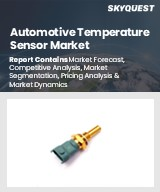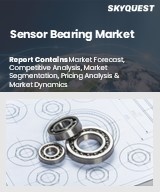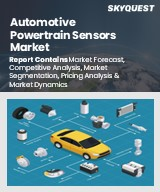
|
시장보고서
상품코드
1433411
세계의 서미스터 온도 센서 시장(2023-2030년)Global Thermistor Temperature Sensor Market 2023-2030 |
||||||
서미스터 온도 센서 세계 시장은 예측 기간(2024-2031년) 동안 연평균 5.4%의 성장률을 보일 것으로 예상됩니다. 시장 성장의 배경에는 세계 자동차 산업의 증가가 있습니다. 전자 시스템의 통합이 증가하고 자동차 부품의 정밀도와 신뢰성이 향상됨에 따라 자동차 산업은 서미스터 온도 센서의 주요 수요처가 되었으며, NTCLE350E4는 이러한 추세에 부응하여 자동차의 엄격한 온도 모니터링 기준을 충족하고 있습니다. 예를 들어, 2021년 2월 Vishay Intertechnology는 PEEK 절연, 니켈철(NiFe) 리드, 낮은 열 구배를 갖춘 새로운 AEC-Q200 인증 NTC 서미스터인 NTCLE350E4를 출시하였습니다. Nife 합금 도체 와이어는 가장 낮은 열전도율을 실현하여 엔진 센서, HVAC, 오일 온도 센서, 변속기 시스템, EGR 시스템에 이상적입니다.
부문별 전망
NTC 하위 부문은 세계 서미스터 온도 센서 시장에서 상당한 점유율을 차지할 것으로 예상
유형별로는 NTC 서브 부문이 세계 서미스터 온도 센서 시장에서 상당한 점유율을 차지할 것으로 예상됩니다. 이 부문의 성장은 전자 기기 및 가전제품에 대한 수요에 기인하며, NTC 서미스터는 가전제품 분야에서 제품의 안전하고 효율적인 작동을 보장하는 데 중요한 역할을 합니다. 전자기기 시장의 성장과 더불어 가젯 및 가전제품에 온도 모니터링 기능이 내장되면서 이 센서 시장의 성장에 기여하고 있습니다. 예를 들어, 2023년 9월, Littelfuse는 NTC 서미스터 시리즈의 표준 재고 공급을 시작했습니다. 서미스터는 열을 감지하고 측정하여 전기 신호로 변환하는 장치로, HVAC, 자동화, 배터리 관리 시스템, 자동차, 의료기기, 전자 기기 등 다양한 응용 분야에서 사용되고 있습니다.
지역별 전망
세계 서미스터 온도 센서 시장은 북미(미국, 캐나다), 유럽(영국, 이탈리아, 스페인, 독일, 프랑스, 기타 유럽 지역), 아시아태평양(인도, 중국, 일본, 한국, 기타 아시아 지역), 기타 지역(중동 및 아프리카, 중남미) 등 지역별로 세분화되어 있습니다. 그 중에서도 북미는 스마트홈 앱의 이용 확대가 시장 성장에 큰 영향을 미칠 것으로 예상됨에 따라 전 세계 전체에서 큰 비중을 차지할 것으로 예측됩니다. 예를 들어, MDPI에 따르면 2023년 5월 현대 세계의 스마트 기술은 사물인터넷(IoT) 기반 기기를 통해 라이프스타일을 향상시켰습니다. 스마트 홈과 그 기기의 성장률은 2018년부터 2022년까지 5억 개의 애플리케이션에서 7억 개의 어플라이언스로 30% 이상 증가했습니다.
세계 서미스터 온도 센서 시장에서 아시아태평양은 상당한 CAGR로 성장할 것으로 예상
모든 지역 중 아시아태평양은 예측 기간 동안 상당한 CAGR로 성장할 것으로 예상됩니다. 이 지역의 성장 배경에는 전기자동차(EV)의 온도 센서에 대한 수요 증가가 있으며, EV의 인기가 높아짐에 따라 다양한 센서, 특히 서미스터에 대한 수요에 직접적인 영향을 미치고 있습니다. 온도 센서는 배터리 온도를 모니터링하고, 효과적인 냉각 시스템을 보장하며, 다양한 구성요소의 최적 작동 조건을 보장하기 위해 EV에 필수적이며, EV 시장이 성장함에 따라 서미스터와 같은 신뢰할 수 있는 온도 센서에 대한 수요가 증가할 것입니다. 국제에너지기구(IEA)에 따르면, 2023년 전기차 판매량 증가는 지역과 파워트레인에 따라 편차가 있으며, 중국이 시장을 독식하고 있습니다. 2022년 중국의 배터리 전기차(BEV) 판매량은 전년 대비 60% 증가한 440만 대에 달했으며, PHEV 판매량은 약 3배 증가한 150만 대에 달했습니다. PHEV 판매량 증가는 아직은 낮은 수준이지만, COVID-19 이후 호황에 따른 추격을 나타낼 수 있어 추가 검토가 필요합니다. 전체적으로 중국은 전 세계 전기차 신규 등록대수의 60%에 육박하며, 2022년에는 총 1,380만 대의 전기차가 도로를 달렸습니다. 이러한 성장은 구매 장려금 확대, 충전 인프라의 급속한 확장 등 지속적인 정책적 지원에 힘입은 것입니다.
또한, 전기차 부문을 포함한 자동차 산업에서 온도 센서에 대한 수요 증가는 전 세계 각국이 배출가스 감축 목표를 설정하고 엄격한 환경 규제를 시행한 결과입니다. MDPI에 따르면, 전기차 시장의 급격한 성장으로 유명한 중국은 2022년 10월, 2025년까지 신차 판매량의 20%를 전기차로 채우겠다는 야심찬 전기차 보급 목표를 설정했습니다. 현재 추세로 볼 때, 내연기관(ICE)의 연간 배출량은 2040년까지 약 1.9% 감소할 것으로 예상됩니다. 그러나 전기자동차(EV)의 보급은 2040년까지 EV 시장의 성장과 문화적 수용에 큰 영향을 미칠 것으로 예상됩니다. 실제로 전 세계 전기차 인구는 2030년까지 1억 3,000만 대를 넘어설 것으로 추정되며, 2021년 현재 이미 1,200만 대 이상의 전기차가 운행되고 있습니다.
목차
제1장 보고서 개요
- 업계 현황 분석과 성장 가능성 전망
- 조사 방법과 툴
- 시장 내역
- 부문별
- 지역별
제2장 시장 개요와 인사이트
- 조사 범위
- 애널리스트의 인사이트와 현재 시장 동향
- 주요 조사 결과
- 추천사항
- 결론
제3장 경쟁 상황
- 주요 기업 분석
- Analog Devices, Inc.
- 개요
- 재무 분석
- SWOT 분석
- 최근의 동향
- Diodes Inc.
- 기업 개요
- 재무 분석
- SWOT 분석
- 최근의 동향
- Emerson Electric Co.
- 개요
- 재무 분석
- SWOT 분석
- 최근의 동향
- 주요 전략 분석
제4장 시장 세분화
- 서미스터 온도 센서 세계 시장 : 유형별
- PTC
- NTC
- 서미스터 온도 센서 세계 시장 : 최종사용자별
- 화학·석유화학
- 발전
- 금속·광업
- 자동차
- 석유 및 가스
- 식품·음료
- 생명과학
- 항공우주·군
- HVAC(난방, 환기, 공조, 냉동) 시스템
- 기타(오락·게임 산업, 반도체, 재생에너지 분야)
제5장 지역 분석
- 북미
- 미국
- 캐나다
- 유럽
- 영국
- 독일
- 이탈리아
- 스페인
- 프랑스
- 기타 유럽
- 아시아태평양
- 중국
- 인도
- 일본
- 한국
- 기타 아시아태평양
- 세계 기타 지역
제6장 기업 개요
- Honeywell International Inc.
- KOA Corp.
- Littelfuse, Inc.
- Microchip Technology Inc.
- Mitsubishi Materials Corp.
- Murata Manufacturing Co., Ltd
- NIC Components Corp.
- Ohizumi Mfg. Co., Ltd.
- Panasonic Corp.
- Semtech Corp.
- SHIBAURA ELECTRONICS Co. Ltd.
- TDK Corp.
- TE Connectivity Ltd.
- Texas Instruments Inc.
- WINBOND ELECTRONICS CORP.
Global Thermistor Temperature Sensor Market Size, Share & Trends Analysis Report by Type (Positive Temperature Coefficient, and Negative Temperature Coefficient), and by End User (Chemical and Petrochemical, Power Generation, Metal and Mining, Automotive, Oil and Gas, Food and Beverage, Life Sciences, Aerospace and Military, HVAC(Heating, Ventilation, Air Conditioning, and Refrigeration) Systems, and Others), Forecast Period (2024-2031)
The global thermistor temperature sensor market is anticipated to grow at a CAGR of 5.4% during the forecast period (2024-2031). The market's growth is attributed to the increase in the automotive industry across the globe. The combination of the increasing integration of electronic systems and the desire for improved accuracy and dependability in vehicle components, the automotive sector is the primary motivation for thermistor temperature sensors. The NTCLE350E4 is in complying with this trend, satisfying the severe standards of temperature monitoring in automobiles. For instance, in February 2021, Vishay Intertechnology has launched new AEC-Q200 qualified NTC thermistor with PEEK-insulated, nickel-iron (NiFe) leads and a low thermal gradient. The NTCLE350E4 is a high-temperature, high-accuracy thermistor intended for automobiles. The lowest thermal conductivity is provided by its Nife alloy conductor wire, rendering it perfect for engine sensors, HVAC, oil temperature sensors, transmission systems, and EGR systems.
Segmental Outlook
The global thermistor temperature sensor market is segmented on the type, and end user. Based on the type, the market is sub-segmented into positive temperature coefficient, and negative temperature coefficient. Furthermore, based on the end-user, the market is sub-segmented into chemical and petrochemical, power generation, metal and mining, automotive, oil and gas, food and beverage, life sciences, aerospace and military, HVAC, and others. The automotive subcategory is expected to capture a significant portion of the market share within the end-user segment. The growth can be attributed to the automotive industry's demand for these sensors is rapidly increasing owing to the increasing demand for accurately identifying the temperature of a vehicle's petroleum, coolant, and air level to ensure optimal performance.
The Negative Temperature Coefficient (NTC) Sub-Segment is Anticipated to Hold a Considerable Share of the global Thermistor Temperature Sensor Market
Among the type, the negative temperature coefficient sub-segment is expected to hold a considerable share of the global thermistor temperature sensor market. The segmental growth is attributed to the demand for electronics and consumer electronics. NTC thermistors serve a significant purpose in assuring the safe and efficient operation of products in the field of consumer electronics. The rising electronics market, in addition to the incorporation of temperature monitoring in gadgets and appliances, all contribute to the expansion of this sensor market. For instance, in September 2023, Littelfuse, introduced its standard, stocked supply of negative temperature coefficient (NTC) thermistor series. The thermistors detect and measure heat, convert it to electrical signals, and are utilized in a variety of applications such as HVAC, automation, battery management systems, automotive, medical equipment, and electronics.
Regional Outlook
The global thermistor temperature sensor market is further segmented based on geography including North America (the US, and Canada), Europe (UK, Italy, Spain, Germany, France, and the Rest of Europe), Asia-Pacific (India, China, Japan, South Korea, and Rest of Asia), and the Rest of the World (the Middle East & Africa, and Latin America). Among these, North America is anticipated to hold a prominent share of the market across the globe, owing to the increased usage of smart home apps anticipates an enormous influence on market growth. For instance, According to MDPI, in May 2023, the smart technologies in the modern globe enhance lifestyles through internet of things (IoT)-based devices. The growth rate of smart homes and their equipment increased by over 30% from 500 million applications to 700 million appliances between 2018-2022.
The Asia-Pacific Region is Expected to Grow at a Significant CAGR in the global Thermistor Temperature Sensor Market
Among all regions, the Asia-Pacific region is anticipated to grow at a considerable CAGR over the forecast period. Regional growth is attributed to the increased demand for temperature sensors in electric vehicles (EVs). The growing popularity of EVs has an immediate influence on the demand for various sensors, particularly thermistors, in these vehicles. Temperature sensors are essential in EVs for monitoring battery temperature, guaranteeing effective cooling systems, and assuring optimal working conditions for various components. As the EV market grows, the demand for dependable temperature sensors such as thermistors will increase. According to the International Energy Agency (IEA), in 2023, the increase in electric car sales showed variation across regions and powertrains, with China dominating the market. In 2022, battery electric vehicle (BEV) sales in China reached 4.4 million, reflecting a 60% increase from the previous year, while PHEV sales nearly tripled to 1.5 million. The growth in PHEV sales, although still lower overall, warrants further examination as it may indicate catching up on the post-Covid-19 boom. Overall, China accounted for almost 60% of new electric car registrations worldwide, with a total of 13.8 million electric cars on the roads in 2022. This growth can be attributed to sustained policy support, including extended purchase incentives and the rapid expansion of charging infrastructure.
Furthermore, the increased demand for temperature sensors in the automotive industry, including the electric vehicle segment, is a result of countries worldwide setting goals to reduce emissions and implement stringent environmental regulations. These sensors play a essential role in enhancing energy efficiency and battery performance, aligning with the industry's commitment to sustainability. According to the MDPI, in October 2022, the China, known for its fast-growing EV market, has set ambitious targets for EV adoption, aiming for 20% of total new car sales to be electric by 2025, Based on current trends, it is projected that annual emissions from internal combustion engines (ICEs) will decrease by approximately 1.9% until 2040. However, it is expected that the widespread adoption of electric vehicles (EVs) will have a significant impact on the growth and cultural acceptance of the EV market by 2040. In fact, the global EV population is estimated to surpass 130 million units by 2030, with over 12 million EVs already on the road as of 2021.
Market Players Outlook
The major companies serving the thermistor temperature sensor market includes Georg Fischer Ltd., Hitachi, Ltd., Honeywell International Inc., OMEGA Engineering, Inc., Siemens Ltd. and others. The market players are considerably contributing to the market growth by the adoption of various strategies including mergers and acquisitions, partnerships, collaborations, funding, and new product launches, to stay competitive in the market. For instance, in July 2020, in July 2020, Variohm Eurosensor Launched new range of glass and epoxy coated NTC Bead Thermistors in a choice of hermetically sealed glass or epoxy encapsulation.
The Report Covers:
- Market value data analysis of 2023 and forecast to 2031.
- Annualized market revenues ($ million) for each market segment.
- Country-wise analysis of major geographical regions.
- Key companies operating in the global thermistor temperature sensor market. Based on the availability of data, information related to new product launches, and relevant news is also available in the report.
- Analysis of business strategies by identifying the key market segments positioned for strong growth in the future.
- Analysis of market-entry and market expansion strategies. Competitive strategies by identifying 'who-stands-where' in the market.
Table of Contents
1. Report Summary
- Current Industry Analysis and Growth Potential Outlook
- 1.1. Research Methods and Tools
- 1.2. Market Breakdown
- 1.2.1. By Segments
- 1.2.2. By Region
2. Market Overview and Insights
- 2.1. Scope of the Report
- 2.2. Analyst Insight & Current Market Trends
- 2.2.1. Key Findings
- 2.2.2. Recommendations
- 2.2.3. Conclusion
3. Competitive Landscape
- 3.1. Key Company Analysis
- 3.2. Analog Devices, Inc.
- 3.2.1. Overview
- 3.2.2. Financial Analysis
- 3.2.3. SWOT Analysis
- 3.2.4. Recent Developments
- 3.3. Diodes Inc.
- 3.3.1. Overview
- 3.3.2. Financial Analysis
- 3.3.3. SWOT Analysis
- 3.3.4. Recent Developments
- 3.4. Emerson Electric Co.
- 3.4.1. Overview
- 3.4.2. Financial Analysis
- 3.4.3. SWOT Analysis
- 3.4.4. Recent Developments
- 3.5. Key Strategy Analysis
4. Market Segmentation
- 4.1. Global Thermistor Temperature Sensor Market by Type
- 4.1.1. Positive Temperature Coefficient (PTC)
- 4.1.2. Negative Temperature Coefficient (NTC)
- 4.2. Global Thermistor Temperature Sensor Market by End-User
- 4.2.1. Chemical and Petrochemical
- 4.2.2. Power Generation
- 4.2.3. Metal and Mining
- 4.2.4. Automotive
- 4.2.5. Oil and Gas
- 4.2.6. Food and Beverage
- 4.2.7. Life Sciences
- 4.2.8. Aerospace and Military
- 4.2.9. HVAC (Heating, Ventilation, Air Conditioning and Refrigeration) Systems
- 4.2.10. Others (Entertainment and Gaming Industry, Semiconductor and Renewable Energy Sector)
5. Regional Analysis
- 5.1. North America
- 5.1.1. United States
- 5.1.2. Canada
- 5.2. Europe
- 5.2.1. UK
- 5.2.2. Germany
- 5.2.3. Italy
- 5.2.4. Spain
- 5.2.5. France
- 5.2.6. Rest of Europe
- 5.3. Asia-Pacific
- 5.3.1. China
- 5.3.2. India
- 5.3.3. Japan
- 5.3.4. South Korea
- 5.3.5. Rest of Asia-Pacific
- 5.4. Rest of the World
6. Company Profiles
- 6.1. Honeywell International Inc.
- 6.2. KOA Corp.
- 6.3. Littelfuse, Inc.
- 6.4. Microchip Technology Inc.
- 6.5. Mitsubishi Materials Corp.
- 6.6. Murata Manufacturing Co., Ltd
- 6.7. NIC Components Corp.
- 6.8. Ohizumi Mfg. Co., Ltd.
- 6.9. Panasonic Corp.
- 6.10. Semtech Corp.
- 6.11. SHIBAURA ELECTRONICS Co. Ltd.
- 6.12. TDK Corp.
- 6.13. TE Connectivity Ltd.
- 6.14. Texas Instruments Inc.
- 6.15. WINBOND ELECTRONICS CORP.



















